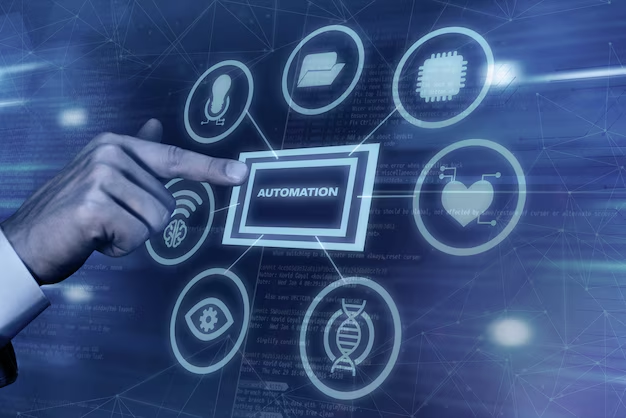Unlocking Efficiency: The Ultimate Guide to AI Automation Tools for Business
In today’s fast-paced commercial world, merely keeping up isn’t enough. Businesses are constantly seeking ways to innovate, scale, and optimize their operations to stay competitive. The answer often lies in technology, and at the forefront of this revolution are AI automation tools for business. These powerful solutions are transforming how companies operate, enhancing productivity, reducing costs, and paving the way for unprecedented growth.
Introduction: Revolutionizing Your Operations with AI Automation
The Evolving Business Landscape: Why Automation is Non-Negotiable
The modern business environment is characterized by relentless competition, escalating customer expectations, and a continuous demand for greater efficiency. Digital transformation is no longer a luxury but a strategic imperative. In this landscape, manual, repetitive tasks are bottlenecks, slowing down progress and draining resources. This is where Artificial Intelligence (AI) steps in, offering sophisticated solutions to automate these processes and unlock new levels of performance. Ignoring automation means falling behind.
Defining AI Automation Tools for Business
What exactly are AI automation tools for business? They are software and platforms that leverage Artificial Intelligence and Machine Learning to perform tasks, streamline workflows, and make intelligent decisions with minimal human intervention. Unlike simple rule-based automation (often called Robotic Process Automation or RPA), AI-powered automation goes further. It incorporates cognitive capabilities like natural language processing, computer vision, and predictive analytics, allowing systems to learn, adapt, and handle more complex, unstructured tasks, mimicking human intelligence.
Who This Guide Is For
This comprehensive guide is designed for anyone looking to propel their organization forward: business owners, department heads, entrepreneurs, operations managers, and strategists eager to scale their operations, boost efficiency, and gain a significant competitive edge through intelligent automation.
What You’ll Learn in This Comprehensive Guide
Throughout this guide, you will gain a deep understanding of why AI automation is critical for modern businesses, explore key functions it transforms, discover leading categories of AI tools with real-world examples, learn strategic implementation approaches, and address potential challenges. We’ll also look ahead to the exciting future of AI in business.
Why AI Automation is a Game-Changer for Modern Businesses
Boosting Operational Efficiency and Productivity
One of the most immediate benefits of AI automation is its ability to handle repetitive, high-volume, and time-consuming tasks. Imagine invoice processing, data entry, or customer query routing being handled instantaneously and around the clock. This leads to significantly faster processing times, eliminates human fatigue, and enables 24/7 operations, drastically boosting overall productivity.
Reducing Costs and Maximizing ROI
By automating routine tasks, businesses can significantly reduce labor costs associated with these operations. Moreover, AI minimizes errors that often lead to rework, compliance fines, and financial losses. With optimized resource allocation and predictive maintenance, AI automation directly contributes to a healthier bottom line and a strong return on investment (ROI).
Enhancing Accuracy and Minimizing Errors
Humans are prone to error, especially when performing monotonous tasks. AI systems, on the other hand, can process vast amounts of data with unparalleled precision and consistency. This eliminates costly mistakes, ensures data integrity, and maintains a high standard of quality across all automated processes.
Freeing Up Human Capital for Strategic Tasks
Perhaps one of the most transformative impacts of AI automation is its ability to liberate employees from mundane chores. When machines handle the routine, human talent can be redirected towards higher-value activities that require creativity, critical thinking, strategic planning, problem-solving, and relationship building. This not only improves job satisfaction but also enhances employee retention and fosters a more innovative workplace culture.
Improving Customer Experience and Personalization
AI-powered tools like chatbots and virtual assistants provide instant responses to customer queries, improving satisfaction and reducing wait times. Furthermore, AI can analyze customer behavior to offer highly personalized recommendations, tailored services, and proactive support, fostering stronger customer loyalty and engagement. For a deeper dive into personalized customer experiences, see this article on Salesforce.
Gaining Data-Driven Insights and Competitive Advantage
AI’s prowess in analyzing enormous datasets allows businesses to uncover hidden trends, identify actionable insights, and make more informed decisions. Predictive analytics can forecast market changes, customer behavior, and operational needs, giving businesses a crucial competitive advantage in strategic planning and rapid adaptation.
Key Business Functions Transformed by AI Automation
Customer Service & Support
- AI Chatbots and Virtual Assistants: Provide instant 24/7 support, answer FAQs, and handle routine inquiries.
- Automated Ticketing and Routing: AI can analyze incoming requests and automatically route them to the correct department or agent.
- Sentiment Analysis: AI assesses customer mood from text or voice, allowing proactive intervention for dissatisfied customers.
Marketing & Sales
- Personalized Email Campaigns and Content: AI crafts targeted messages and recommends relevant content.
- Lead Scoring and Nurturing: AI evaluates lead quality and automates follow-up sequences.
- Predictive Sales Forecasting: AI analyzes historical data to predict future sales trends.
- Automated Ad Optimization: AI adjusts ad spend and targeting in real-time for better performance.
Finance & Accounting
- Automated Invoice Processing and Expense Management: AI extracts data, verifies information, and categorizes expenses.
- Fraud Detection and Compliance: AI identifies suspicious transactions and ensures adherence to regulations.
- Financial Reporting and Forecasting: AI compiles data and generates accurate financial projections.
Human Resources (HR)
- Automated Recruitment Screening and Scheduling: AI analyzes resumes, shortlists candidates, and schedules interviews.
- Onboarding Process Automation: Streamlines paperwork, task assignments, and initial training.
- Employee Data Management and Analytics: AI helps manage employee records and derive insights into workforce trends.
Operations & Supply Chain Management
- Inventory Optimization and Demand Forecasting: AI predicts optimal stock levels and future demand.
- Logistics and Route Optimization: AI plans the most efficient delivery routes and schedules.
- Quality Control and Predictive Maintenance: AI monitors equipment for potential failures, reducing downtime.
Data Analysis & Business Intelligence
- Automated Data Collection and Aggregation: AI gathers data from disparate sources.
- Generating Reports and Dashboards: AI compiles complex data into digestible visual formats.
- Identifying Hidden Patterns and Correlations: AI uncovers insights that human analysts might miss.
Content Creation & Management
- Generating Draft Content: AI assists in writing articles, social media posts, and product descriptions.
- Summarizing Documents and Transcribing Audio: AI condenses long texts and converts speech to text.
- Content Localization and Translation: AI rapidly translates and adapts content for different regions.
Top Categories of AI Automation Tools for Business (and Examples)
AI-Powered Chatbots & Virtual Assistants
- Description: Conversational AI designed to interact with users, provide information, answer queries, and qualify leads in real-time.
- Examples: Zendesk Answer Bot, Intercom Fin, Drift, HubSpot Chatbot.
Robotic Process Automation (RPA) Solutions with AI
- Description: Software robots that mimic human actions to automate structured, rule-based processes, now often enhanced with AI for cognitive tasks like understanding unstructured data.
- Examples: UiPath, Automation Anywhere, Blue Prism.
Predictive Analytics & Business Intelligence Platforms
- Description: Tools that utilize machine learning algorithms to analyze historical data, forecast future outcomes, and deliver actionable insights for strategic decision-making.
- Examples: Tableau (with AI features), Salesforce Einstein, Google Cloud AI Platform, Microsoft Azure Machine Learning.
AI Content Generation & Optimization Tools
- Description: Platforms that leverage Natural Language Processing (NLP) to assist in creating, refining, and summarizing text-based content, from marketing copy to detailed articles.
- Examples: Jasper, Copy.ai, Grammarly Business, Surfer SEO (for content optimization).
Intelligent Document Processing (IDP) & OCR
- Description: AI-driven tools that extract, classify, and process data from various structured and unstructured documents (invoices, forms, contracts), often using Optical Character Recognition (OCR).
- Examples: ABBYY FlexiCapture, Kofax, Google Cloud Document AI.
Personalization & Recommendation Engines
- Description: AI systems that analyze user behavior, preferences, and historical data to deliver highly tailored experiences, product suggestions, and content recommendations.
- Examples: Dynamic Yield, Optimizely, HubSpot (CRM features with personalization).
CRM & ERP Integrations with AI
- Description: Existing Customer Relationship Management (CRM) and Enterprise Resource Planning (ERP) systems augmented with AI capabilities to enhance forecasting, automate tasks, and provide deeper insights.
- Examples: Salesforce Sales Cloud (with Einstein AI), SAP AI Business Services, Oracle AI.
Implementing AI Automation: A Strategic Approach for Businesses
Assessing Your Business Needs & Goals
Before diving in, clearly identify your organization’s pain points, operational bottlenecks, and areas where automation can yield the highest ROI. Define precise, measurable objectives, such as “reduce customer wait time by 30%” or “increase lead conversion by 15%.”
Identifying Key Automation Opportunities
Prioritize tasks that are highly repetitive, high-volume, rule-based, or error-prone. These are typically the low-hanging fruit for AI automation. Start with smaller, high-impact projects to build momentum and demonstrate value quickly.
Choosing the Right AI Automation Tools
Evaluate tools based on their scalability, integration capabilities with your existing systems, ease of use, and the level of vendor support. Always conduct a thorough cost-benefit analysis, considering both upfront investment and ongoing maintenance.
Starting Small & Scaling Up
Implement pilot programs or proof-of-concept projects in a contained environment. This allows your team to learn, identify potential issues, and refine processes before a wider rollout. Embrace iterative deployment and continuous improvement.
Training Your Team & Change Management
Successful adoption hinges on your team. Provide comprehensive training and communicate clearly how AI empowers employees, rather than replaces them. Address fears of job displacement by highlighting opportunities for upskilling and focusing on how AI augments human capabilities.
Monitoring Performance & Iterating
Establish clear Key Performance Indicators (KPIs) to track the impact of your AI automation initiatives. Regularly review performance data, gather feedback, and be prepared to optimize and iterate on automated processes to ensure they continue to meet evolving business needs.
Potential Challenges and Considerations with AI Automation
Data Privacy & Security Concerns
AI systems often require access to vast amounts of data, raising critical concerns about privacy and security. Businesses must ensure compliance with regulations like GDPR and CCPA and conduct thorough due diligence on vendors to protect sensitive information.
Integration Complexities
Integrating new AI tools with existing legacy systems can be challenging. Compatibility issues, API limitations, and the need for custom development can increase complexity and cost. Careful planning is essential.
The “Human Element” & Job Displacement Myths
One of the biggest hurdles is often overcoming employee anxiety about job security. It’s vital to frame AI as an “augmentation” tool that enhances human capabilities, rather than a “replacement.” Investing in reskilling and upskilling initiatives can foster a positive attitude towards AI adoption.
Cost of Implementation & Maintenance
While AI automation offers long-term cost savings, the initial investment in software, infrastructure, integration, and training can be substantial. Businesses must account for subscription fees, ongoing support, and potential hidden costs to avoid budget overruns.
Ethical AI Use and Bias
AI systems learn from the data they are fed. If this data contains biases, the AI can perpetuate and even amplify them, leading to unfair or discriminatory outcomes. Ensuring fairness, transparency, and accountability in AI decisions, and actively mitigating biases in training data, is a critical ethical consideration. Learn more about AI ethics on IBM’s resource page.
The Future of Business Automation with AI
Hyperautomation & Intelligent Process Automation (IPA)
The trend is moving towards hyperautomation, which combines RPA with AI, Machine Learning (ML), Process Mining, and other advanced technologies to achieve end-to-end automation of complex processes. This leads to Intelligent Process Automation (IPA) where systems can make autonomous decisions and adapt dynamically.
Enhanced Human-AI Collaboration
The future workplace will feature more seamless human-AI collaboration, with AI acting as a “co-pilot” rather than just a tool. More intuitive interfaces will allow humans to interact with AI more naturally, leveraging each other’s strengths to achieve superior outcomes.
AI Ethics and Governance in Focus
As AI becomes more pervasive, there will be an increasing focus on developing robust ethical guidelines and regulatory frameworks. Industry standards and governmental oversight will ensure responsible AI development and deployment, prioritizing transparency, fairness, and accountability.
Accessible AI for SMEs
The democratization of AI tools will continue, making advanced AI capabilities more accessible and affordable for Small and Medium-sized Enterprises (SMEs). This will level the playing field, allowing smaller businesses to leverage the same transformative power of AI previously available only to large corporations.
Conclusion: Embrace the AI Automation Revolution
Recap of Key Benefits
AI automation tools for business are not just a trend; they are a fundamental shift in how organizations achieve efficiency, drive growth, and enhance customer satisfaction. By automating mundane tasks, reducing costs, minimizing errors, and freeing human potential, AI offers a transformative pathway to operational excellence and strategic advantage.
Final Encouragement & Call to Action
The time to embrace the AI automation revolution is now. Don’t be left behind in a rapidly evolving digital landscape. Start your AI automation journey today by identifying your key pain points and exploring the tools that can revolutionize your operations. For personalized guidance, consider downloading our comprehensive AI Automation Checklist or contacting an expert for a tailored consultation to help your business thrive in the age of intelligent automation.




